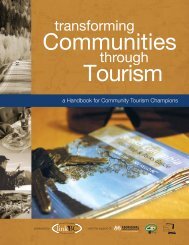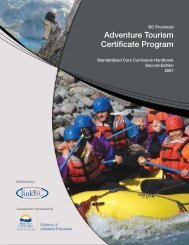Cultural Heritage Tourism Handbook - LinkBC
Cultural Heritage Tourism Handbook - LinkBC
Cultural Heritage Tourism Handbook - LinkBC
- No tags were found...
Create successful ePaper yourself
Turn your PDF publications into a flip-book with our unique Google optimized e-Paper software.
What is <strong>Cultural</strong>/<strong>Heritage</strong> <strong>Tourism</strong>?Given the many definitions of “culture,” it’s hardly surprising there are many definitions for cultural/heritage tourism–also known simply as cultural tourism or heritage tourism:• “Culture and heritage tourism occurs when participationin a cultural or heritage activity is a significant factor for traveling.<strong>Cultural</strong> tourism includes performing arts (theatre, dance, music),visual arts and crafts, festivals, museums and cultural centres, andhistoric sites and interpretive centres.” – Canadian <strong>Tourism</strong> Commission 3• “The movement of persons to cultural attractionsin cities in countries other than their normal place of residence,with the intention to gather new information and experiencesto satisfy their cultural needs and (2) all movements of personsto specific cultural attractions, such as heritage sites, artisticand cultural manifestations, arts and drama to cities outside• “<strong>Heritage</strong> tourism is travel directed toward experiencingthe heritage of a city, region, state or country. This travel enablesthe tourist to learn about, and be surrounded by, local customs,traditions, history and culture. – Texas Historical Commission 5• “Travel directed toward experiencing the arts, heritage, andspecial character of a place. America’s rich heritage and culture,rooted in our history, our creativity and our diverse population,provides visitors to our communities with a wide variety ofcultural opportunities, including museums, historic sites, dance,music, theatre, book and other festivals, historic buildings, artsand crafts fairs, neighbourhoods, and landscapes.” – US NationalThe Link between <strong>Heritage</strong> Conservation and <strong>Tourism</strong>The ties between tourism and heritage conservation have beengrowing stronger in recent years. In 1999, the International Councilon Monuments and Sites (ICOMOS) created the International<strong>Cultural</strong> <strong>Tourism</strong> Charter – Managing <strong>Tourism</strong> at Places of <strong>Heritage</strong>Significance. Its key principles are 8 :1. Since tourism is among the foremost vehicles for culturalexchange, conservation should provide responsible andwell-managed opportunities for members of the hostcommunity and visitors to experience and understand thatcommunity’s heritage and culture first-hand.2. The relationship between heritage places and tourismis dynamic and may involve conflicting values. It shouldbe managed in a sustainable way for present and futuregenerations.3. Conservation and tourism planning for heritage placesshould ensure that the visitor experience will be worthwhile,satisfying and enjoyable.4. Host communities and indigenous peoples should beinvolved in planning for conservation and tourism.5. <strong>Tourism</strong> and conservation activities should benefit the hostcommunity.6. <strong>Tourism</strong> promotion programs should protect and enhancenatural and cultural heritage characteristics.These principles demonstrate that heritage conservation recognizestourism is here to stay, and is seeking ways to live harmoniously.They make clear that cultural/heritage tourism operators havea responsibility to the host community, to the visitor, and to theresources on which their industry is based.their normal country of residence.”– UN World <strong>Tourism</strong> OrganizationEndowment for the Arts et al. 6and European Travel Commission 4• “Geotourism is defined as tourism that sustains or enhancesthe geographical character of a place—its environment, culture,aesthetics, heritage, and the well-being of its residents.” – Centerfor Sustainable Destinations - National GeographicCanadian <strong>Cultural</strong> <strong>Tourism</strong> PrinciplesThe Charter was echoed in three core principles outlined by the Canadian <strong>Tourism</strong> Commissionin Packaging the Potential: A Five-Year Business Strategy for <strong>Cultural</strong> and <strong>Heritage</strong> <strong>Tourism</strong> In Canada(1999), which states cultural and heritage tourism:Together, these definitions paint a colourful picture of the many dimensions of this sector. Thedefinition below brings to life the concept of community-based cultural/heritage tourism—whichis a key focus of this handbook:• Involves a quality visitor encounter with a cultural or historicexperience that is authentic, and that is not created solely for thepurpose of attracting tourists.• Must be sustainable and must ensure that the quality and integrityof the cultural or heritage resource/experience are conserved.• Is based on a mutually beneficial partnership between the cultural/heritage and tourism sectors, and must be a revenue generatorfor both sectors.“<strong>Cultural</strong> <strong>Tourism</strong> embraces the full rangeof experiences visitors can undertake tolearn what makes a destination distinctive– its lifestyle, its heritage, its arts, itspeople–and the business of providing andinterpreting that culture to visitors.”– Commonwealth of Australia, Creative Nation 78 9










